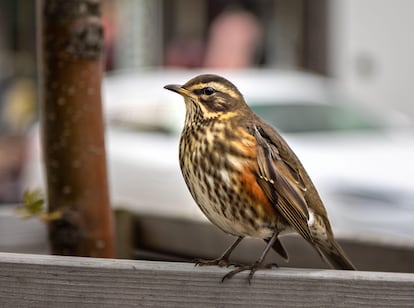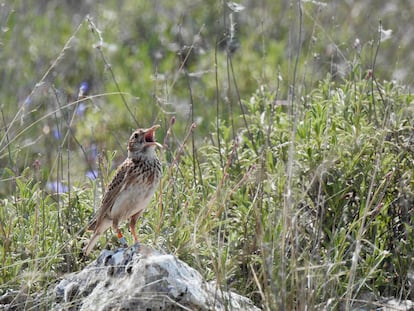Human lights have lengthened the birds' song

In the most well-lit areas of the planet, mostly cities, birds sing up to an hour longer than in areas free of light pollution . The data, published in the journal Science , is one of the results of a study involving millions of songs from hundreds of species. This suggests that birds begin their daytime activity earlier and rest later, perhaps sensing that the days are longer. The earlier onset of their vocalizations at dawn and the fact that they continue singing after the sun has set could be affecting aspects of their lives as basic as reproduction, exposure to predators, and their migrations.
Most humans of this generation will stop seeing the stars . But the problem of light pollution, multiplied by LED technology, goes far beyond human health : a comprehensive study was recently published showing that, in cities, spring has come earlier while autumn is being delayed, altering plant phenology . On the impact of light pollution on animals, there are many studies on specific species, such as the drama of fireflies , and a few compilations of studies showing how lights are disrupting animal life . What has been lacking is extensive research involving any of the major groups of animals.
This is what a pair of American biologists have done, supported by two large sets of big data , to show what light pollution is doing to birds: On the one hand, they relied on light pollution data collected by a set of NASA satellites , which record artificial light emitted from all points on the planet. On that map, they placed more than 180 million songs, chirps, trills, vocalizations... of more than half a thousand species of diurnal birds recorded in nearly 8,000 locations between March 2023 and the same month in 2024. All these sounds are hosted on BirdWeather , a platform that visualizes and organizes the millions of recordings made by BirdNet volunteers, an impressive citizen science project.

By combining both sets of data, the researchers found that the birds lengthened their calls by an average of 50 minutes in the most illuminated areas, compared to conspecifics of the same species that live in less-lit areas, such as rural or forested areas. The change in the start of the day is somewhat smaller than that which occurs at the end of the day. Specifically, they advanced the beginning of their calls at dawn by 18 minutes and delayed their silence at dusk by another 32 minutes. These are averages; some birds, such as the common blackbird, have extended their day by almost two hours. Others stand out for their early start, such as the goldfinch or the redwing, a small bird that calls 58 minutes earlier in areas where there is more light pollution.
“We were also curious about nocturnal species, so we conducted a full analysis of this group in a companion paper,” Brent Pease , a professor of biodiversity conservation at Southern Illinois University (USA) and co-author of the study, said in an email. “We expected the opposite response to diurnal species: they should have shorter activity periods in light-polluted landscapes. However, in summary, we found little evidence that nocturnal bird species exhibit truncated activity in response to pollution.” However, they did observe that nocturnal birds vocalize less in brightly lit environments.
Vocalizations are an essential aspect of the bird world. Some warn of the presence of predators, while others mark territory. The best songs are used for courtship. And young birds call for food with their chirping . They are the best indicator of a bird's daily activity, and programs like BirdNet allow us to identify which species is singing. But they also help us understand other aspects that recordings don't capture. As Neil Gilbert, a professor at Oklahoma State University (United States) and co-author of the research, says, "vocalizations are just one aspect of bird behavior; it's what we can measure most easily on a large scale, given the current state of technology."

The authors of the study investigated which traits or behavioral patterns make a bird more vulnerable to light pollution. Some seemed obvious, but needed confirmation. Such as eye size: species with larger eyes, typical of shady landscapes such as the understory, are among those that have most affected the duration of their calls. This is the case with the American robin and a close relative, the blackbird. The same is true for birds that breed in open nests, such as sparrows, compared to swallows, which nest in mud structures with a small hole. Migratory species are also among those affected. Although diurnal, most of them take advantage of the night to migrate. A critical dimension is the impact of human lights during the breeding season.
What the authors leave open is the impact this increased daily activity in the form of song could have. In some species, the earlier song date has favored additional copulatory activity outside the pair. Swifts, for example, extend their flights in search of insects because they believe it is still dusk . Among swallows, a study conducted in Chinese cities showed that with more light, parents spent more time providing food for their young, so light pollution may be favoring their reproductive success.
University of Alicante researcher Cristian Pérez, who was not involved in this study, points out that artificial light has many other impacts beyond the earlier call times. “Especially on bird migration. In New York and certain areas of the United States, they turn off their lights when Cornell's predictive models predict there will be strong migration flows.” The Cornell Lab of Ornithology, at the university of the same name, is one of the world's leading centers dedicated to the study of birds. Although the Spaniard has not studied the impact of light pollution directly, he has monitored the behavior of the lark, which calls earlier on nights with a full moon. However, what Pérez highlights most about this new research is that thanks to citizen science platforms, “we can answer ecological questions that would otherwise be impossible.”
Ornithologist Pablo Capilla from the Swiss Ornithological Institute has investigated the impact of lights on several species of birds. Capilla recalls that the connection between light pollution and changes in the duration of birdsong had already been studied, "but the database they use is brutal." Also a CSIC researcher, Capilla is currently monitoring several pairs of European scops owls, a small species of owl. The objective of the MIGRALIGHT project is to study the impact of light pollution on the migratory pattern of this species, which spends spring and summer in southern Europe and winters in the African Sahel. "The data is still very preliminary, but scops owls that live in cities or are exposed to environmental factors associated with humans have a lower migratory tendency." What has already been observed is that a species that used to migrate is becoming increasingly resident, and this could be due to human-induced lights.
EL PAÍS



